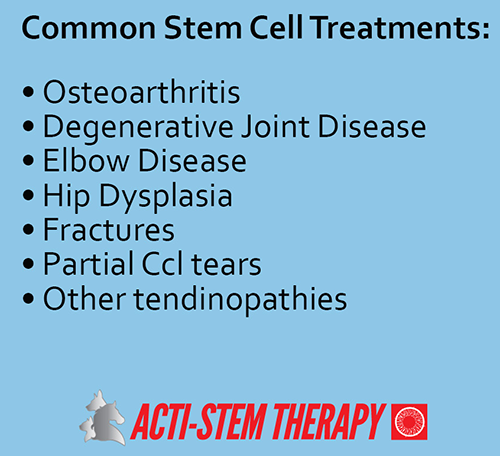Bellevue Crossroads Vet Services
Stem Cell Therapies

What is Ardent Stem Cell Therapy?
Stem cells are powerful healing cells in your body that can become other types of cells. There are many adult stem cells in fat tissue, however they are asleep. Ardent’s stem cell therapy allows your vet to isolate stem cells from an animal’s own fat tissue, wake them up, and reinject them directly into damaged areas. For example, in the case of arthritis, stem cells become new cartilage cells, thus reducing pain and increasing mobility.
 What is so great about Stem Cell Therapy?
What is so great about Stem Cell Therapy?
Stem cells treat the source of the problem by becoming new tissue to replace damaged tissue. Other treatments, such as NSAIDs, merely attempt to reduce symptoms. The treatment is very low risk, because it uses the animal’s own stem cells. With Ardent’s technology, over 95% of animals treated show improvement.
How long has this been available?
Stem cell therapy for animals has been commercially available since 2004. Ardent started selling their kits in the US in 2010, to clinics on the mainland, and thousands of animals have been treated around the world. An Ardent representative now lives in Hawaii and began introducing it to clinics here in 2012.
I’ve heard about other stem cell companies. Which one is best?
For pet owners, there are two main advantages to Ardent. First, the processing is all done in your vet’s office, so you don’t need to worry about losing your sample during shipping, or the sample heating up and getting damaged. Also, Ardent allows your vet to do the entire procedure in one day, making it very convenient for you and your pet. While all companies are equally safe, Ardent has the highest reported success rate of greater than 95%. When comparing side by side, vets chose Ardent because of the superior results.
Is it safe?
Yes, this procedure is very safe. The biggest risk is using anesthetic, to remove the fat tissue. On a typical dog, this is easier than a spay, and the fat is collected in about 15 minutes by your vet. Processing the sample is done carefully by a highly trained Ardent representative (or by a lab tech carefully trained by that representative). In the thousands of animals treated, we have not observed any negative side-effects from Ardent’s stem cell therapy.
What happens to my pet when they come in for stem cell therapy?
First, your vet will put your pet under general anesthetic. Then, he/she will make a small incision and collect 2-4 tablespoons of fat (either in the belly or behind the shoulder blades). Since your pet is under anesthetic, this is a great opportunity to do anything else needed – spay/neuter, or dental for example. Your local, highly trained Ardent representatives will then process the sample, right in the clinic, using Ardent equipment. After about 3 hours, the cells are ready for injection into areas of damage. In addition, some cells are administered IV. For the administration step, your pet will either not sedated at all, locally anesthetized with ethyl chloride spray, or lightly sedated, depending on what’s best for your pet. You can pick up your pet later that same day.
What is the recovery period, and how long does it take to see results?
We recommend that the patient be kept quiet for the first 10 days. Then, while they may feel a lot better, you will need to be careful so your pet doesn’t injure themselves until they build up some of their muscles. Swimming and walking in water is great therapy. We typically see improvement starting after 3 weeks, and then continuing up to around 2 months.
 What conditions do you treat?
What conditions do you treat?
Our typical patient has osteoarthritis (hip dysplasia, degenerative joint disease, calcifications, common degeneration and inflammation), soft tissue injuries (cruciate injuries, tears, ruptures, inflammation), or needs accelerated healing of fractures. We know a lot about these conditions, and over 95% of these patients get better, with Ardent’s Stem Cell Therapy. We also treat other cases under “compassionate use”. We know less about these conditions, but are seeing some exciting results. Some of those conditions are: degenerative myelopathy, feline gingivitis, end-stage renal disease, liver and kidney failure, allergy, auto-immune, inflammatory bowel disease, pulmonary fibrosis, IMHA, atopy, and spine trauma. Please talk to your vet if you have questions about any of these conditions.
How long does a treatment last? What happens if my pet starts having trouble again?
Most pet owners chose to bank cells, so retreatment is easy. Ardent has a banking facility in Kentucky. If symptoms return, your vet merely requests a dose of cells from the bank, and injects them. No surgery is necessary. Potentially life long cure as I have witnessed
Are there any animals that you don’t treat?
Yes. Because we don’t know exactly what happens when cancer patients are treated with stem cells based on human studies, we do not treat those patients.

